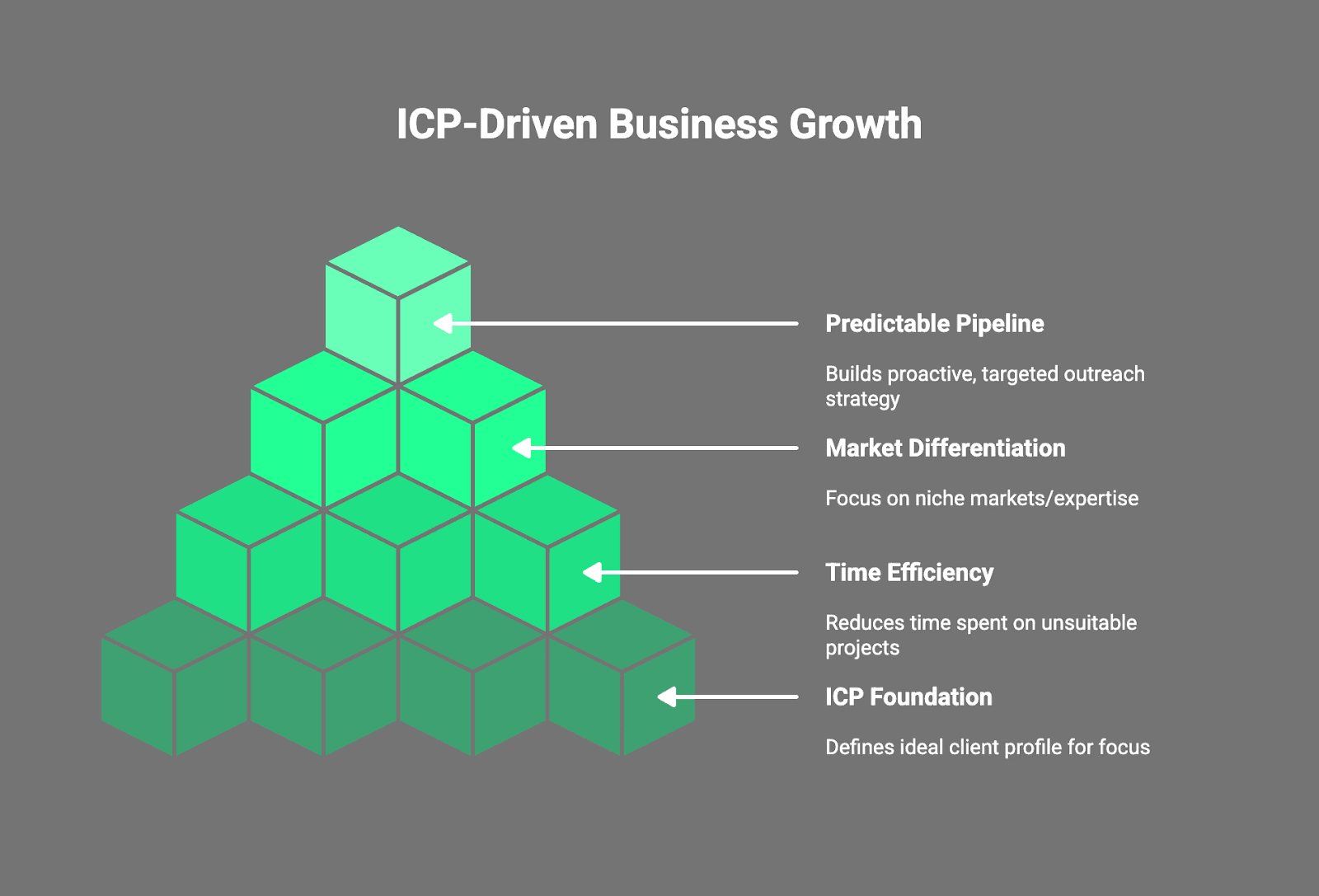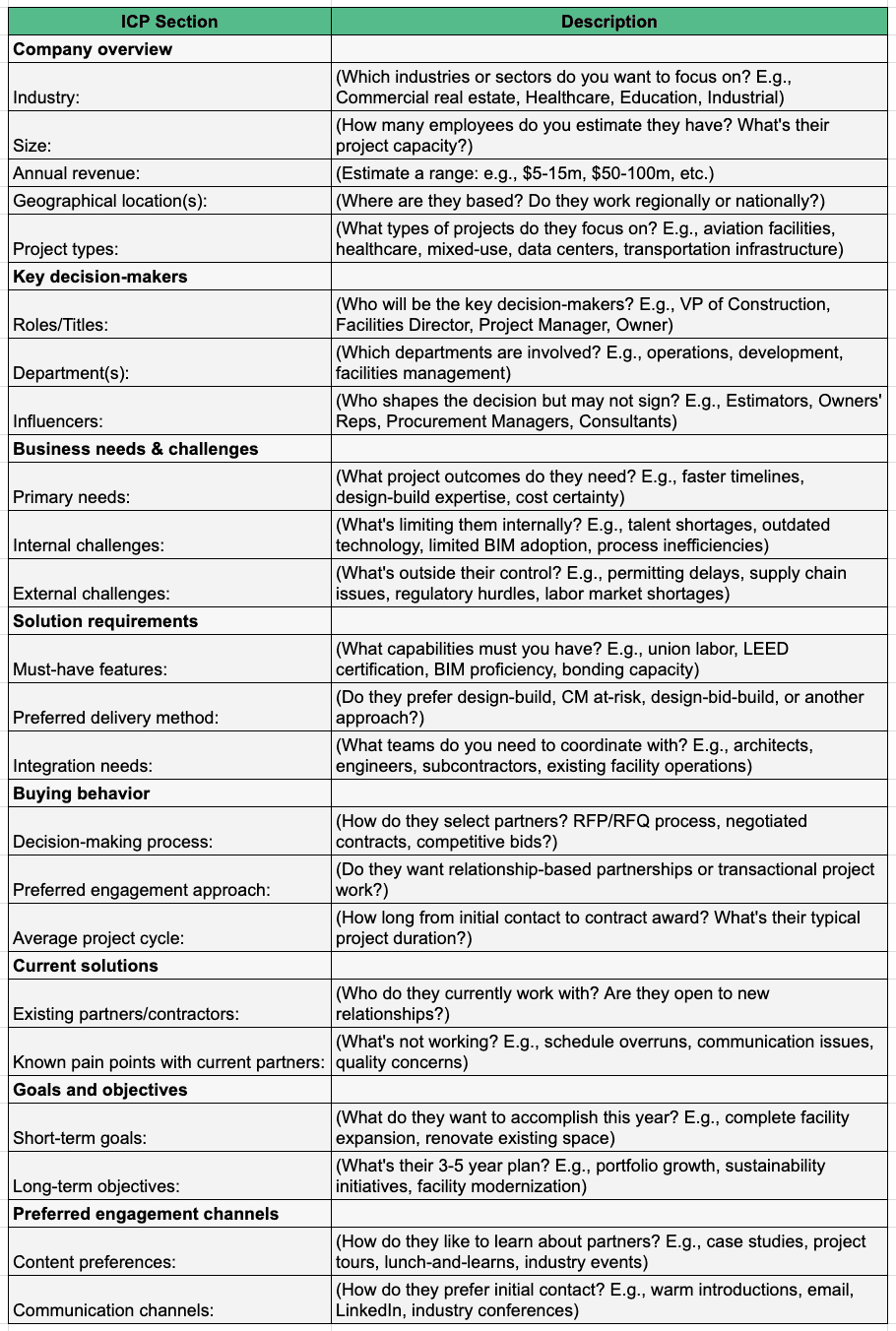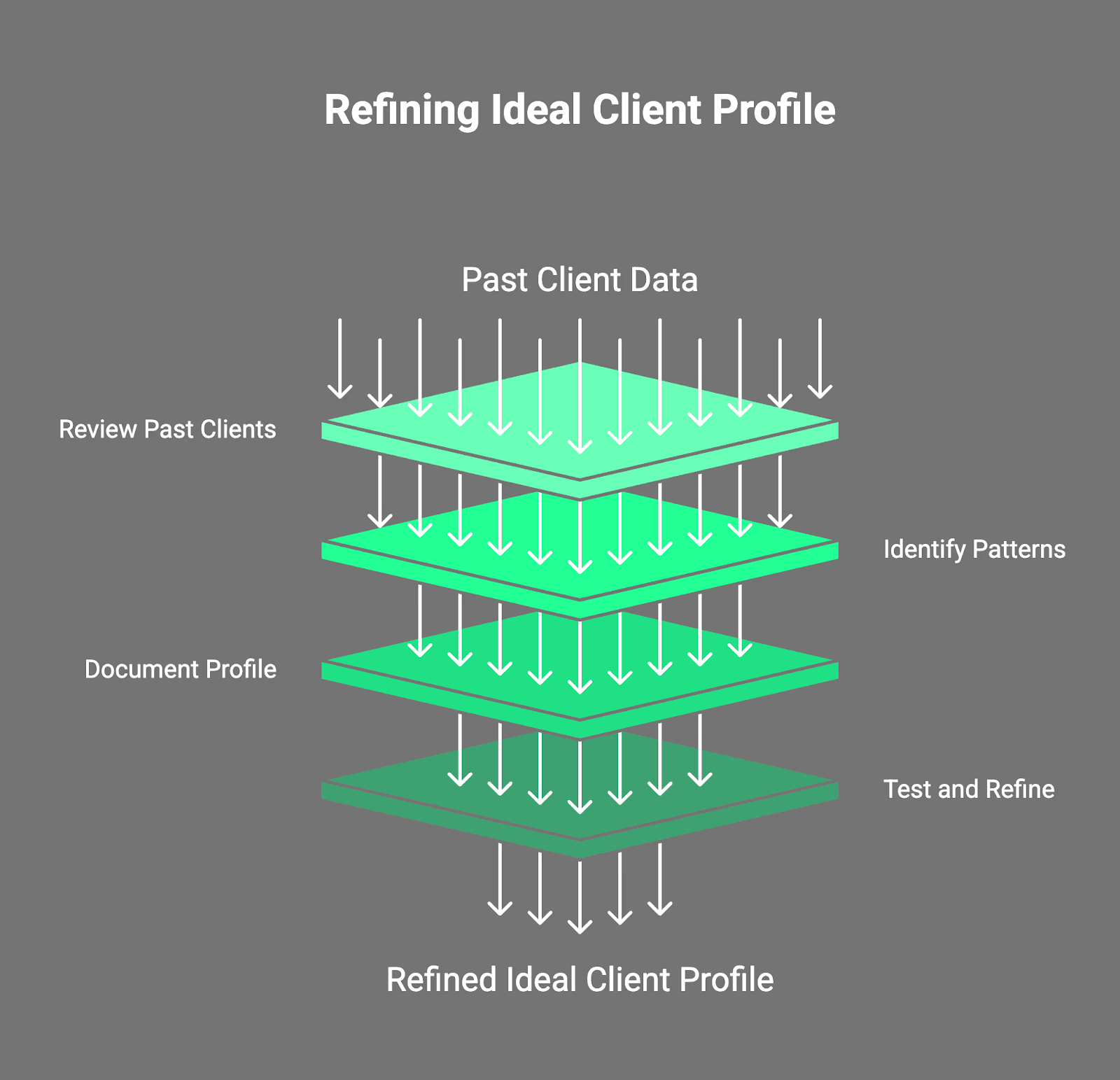What is an Ideal Customer Profile (ICP) and Why Your AEC Firm Needs One
Published on
12:31 PM
Published by
Terry Robinson

Contents
You're investing hours into proposals for projects you'll never win.
Meanwhile, your competitors are closing deals in half the time with half the effort.
The difference?
They know exactly who they're selling to.
Most AEC firms operate in reactive mode. A lead comes in, you chase it. Someone requests a proposal, you write it.
But here's the problem: not every opportunity is worth pursuing, and when you treat every lead the same, you end up spinning your wheels on projects that were never a good fit to begin with.
The solution isn't working harder. It's getting clearer about who you're actually built to serve.
That's where an Ideal Customer Profile comes in.
What is an Ideal Customer Profile (ICP)?
An Ideal Customer Profile is a detailed description of the type of client your firm serves best.
Not the clients you can serve. The ones you should serve.
It's more specific than a target market. A target market might be "commercial real estate developers." An ICP drills down further: "Mid-sized commercial developers in the Southeast managing $5-15M mixed-use projects who value speed-to-market and work with design-build teams."
See the difference?
An ICP forces you to get specific about industry, project type, budget, geography, timeline, and decision-making style. It's not about who you could theoretically help. It's about identifying the clients where you deliver the most value and they're happiest with the results.
In AEC marketing, this specificity matters more than most industries. Projects aren't one-size-fits-all. A firm built for ground-up healthcare construction operates differently than one focused on historical renovations. The more precisely you define your ideal client, the easier every other marketing and sales decision becomes.
Why Your AEC Firm Needs an ICP
1. Stop Wasting Time on Wrong-Fit Projects
Without an ICP, you have no filter. Every RFP looks like an opportunity. So you chase them all and wonder why your win rate stays stuck at 20% or lower.
You spend hours customizing proposals for projects you're not equipped to win. Your team burns out. Your pipeline looks busy but produces inconsistent results. Revenue feels like a roller coaster.
An ICP gives you permission to say no. It helps you spot red flags early and frees up time to focus on opportunities that actually match your strengths and desired clientele.
Shorten Your Sales Cycle
When you know exactly who you're built to serve, everything moves faster. You speak their language. You understand their pain points. Your proposals address their specific concerns because you've solved this exact problem before.
Right-fit clients don't need convincing. They recognize you get it. Compare that to wrong-fit prospects who ask for endless revisions, question your pricing, and need their hand held through every decision.
An ICP helps you spend time with people who are actually ready to move forward.
Differentiate in a Commoditized Market
Every AEC firm says the same things: "Quality work, on time, on budget."
When everyone sounds identical, clients default to price.
An ICP forces you to pick a lane. When you're clear about who you serve, you develop specialized expertise and build relevant case studies. You stop being "a general contractor" and become "the general contractor for adaptive reuse projects in historic districts."
That specificity makes you the obvious choice for the right client.
Build Predictable Pipeline
Most AEC firms depend on referrals and RFPs. That's not a strategy. That's hope.
When you have a clear ICP, targeted outreach becomes possible. You can identify companies that match your profile and build relationships before they have an active project.
This shifts you from reactive to proactive. Instead of waiting for opportunities to find you, you're building a pipeline of right-fit prospects. That's how you smooth out the feast-or-famine cycle.

The Basic Elements of an AEC Ideal Customer Profile
So what actually goes into an ICP? Here are the core elements every AEC firm should define:
Firmographics
This is your client's company profile. What industry are they in? How big is their organization? What's their annual revenue range? Are you targeting prime consultants, mid-sized regional players, or smaller companies?
In AEC, firmographics matter because they influence everything from budget to decision-making speed to contract terms.
Industry/Sector Focus
Are you serving commercial, residential, industrial, institutional, or infrastructure clients? Each sector has different needs, timelines, and buying behaviors. A firm focused on K-12 education operates differently than one built for multi-family housing.
Project Type and Size
What kind of projects do you excel at? Ground-up construction? Renovations? Tenant improvements? What's your sweet spot in terms of square footage or project scope? This isn't about what you're capable of—it's about where you consistently deliver your best work.
Geographic Location
Are you local, regional, or national? Do you serve specific metro areas or states? Geography affects everything from mobilization costs to permitting knowledge to relationship-building opportunities.
Budget Range
What's your ideal project budget? You might be able to handle a $500K job and a $50M job, but which one plays to your strengths? Where do your systems, team size, and expertise create the most value?
Decision-Making Structure
Who makes the final call? Is it a single owner, a board, a committee? How long does their approval process take? Understanding this helps you navigate the sales process, set realistic timeline expectations, and develop the appropriate lead nurturing process.
Timeline Expectations
Are your ideal clients working on fast-track projects or multi-year developments? Do they value speed or perfection? Aligning on timeline expectations prevents mismatched priorities down the road.
Values Alignment
What matters most to your ideal client? Sustainability? Cost control? Design aesthetics? Cutting-edge technology? Safety record? When your values match theirs, projects run smoother and relationships last longer.
ICP Template for AEC Firms
In the ICP template below, we've included all the key areas you should consider and guidance on what to include in each section. It's best tailored to your business needs and should evolve as you learn more about your ideal clients.

You don't need to overthink this. Start simple.
Step 1: Review Your Best Past Clients
Look at the last 10-20 projects you've completed. Which ones were most profitable? Which clients were easiest to work with? Which projects showcase your team's strengths?
Don't just think about revenue. Think about the entire experience. Which projects ran smoothly? Which clients referred you to others? Which ones would you clone if you could?
Step 2: Identify Common Patterns
What do those best clients have in common? Look for patterns in industry, project type, budget, location, and decision-making style.
You're looking for overlap. If 7 out of your 10 best clients fit a similar profile, that's your signal.
Step 3: Document the Profile
Write it down. Be specific. Use the elements we covered earlier (firmographics, project type, budget range, geography, etc.).
This isn't set in stone forever, but you need a documented starting point. Share it with your team so everyone's aligned on who you're pursuing.
Step 4: Test and Refine Over 90 Days
Use your ICP as a filter for the next three months. Evaluate new opportunities against it. Track what happens when you stick to your profile versus when you deviate.
After 90 days, adjust based on what you learned. Maybe your budget range needs tweaking. Maybe you discovered a sub-niche within your ICP that's even more profitable.
The goal isn't perfection on day one. It's clarity that improves over time.

Stop Chasing Every Lead and Start Attracting the Right Ones
Here's the truth most AEC firms don't want to hear: you can't serve everyone.
The firms that try end up struggling to fill up their sales pipeline. The ones that get specific about who they serve become exceptional at something.
An Ideal Customer Profile isn't about limiting your opportunities. It's about multiplying your effectiveness.
When you know exactly who you're built to serve, your marketing gets sharper. Your proposals get stronger. Your sales conversations get shorter. Your projects run smoother. And your revenue becomes predictable instead of random.
Most importantly, you stop wasting time on the wrong opportunities and start investing it in the right ones.
Ready to define your Ideal Customer Profile and build a predictable pipeline for your AEC firm?
We help architecture, engineering, and construction companies get crystal clear on who they serve best—and build marketing systems that attract those exact clients.
Schedule a free consultation and we'll walk through your past projects, identify your highest-value client patterns, and help you build an ICP that transforms how you win work.
Get Weekly Marketing Tips
Join other AEC professionals to get the best marketing tips every week in your inbox



